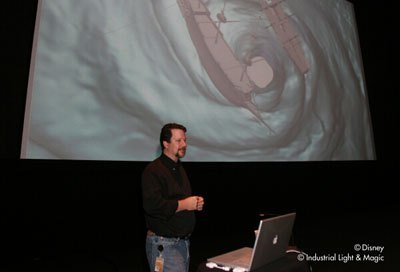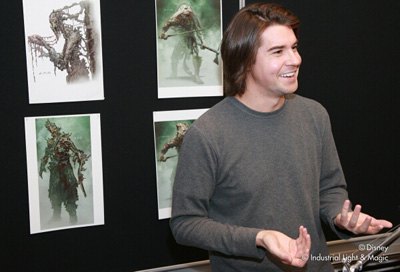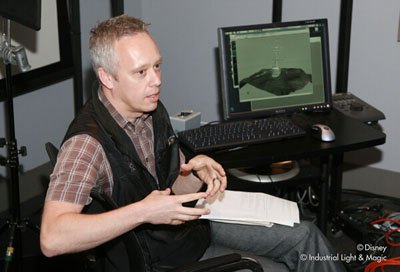
 |
|
| |||||||||||
|
Pirates of the Caribbean: At World's End - ILM
Okay, you've already read what goes into the making of a
pirate. To get a look at some of the other elements that went into bringing to life Pirates of the Caribbean: At
World's End -- the final installment of the trilogy that's just washed ashore on DVD and Blu-ray disc -- we turned to
Industrial Light and Magic, who were kind enough to invite DVD Talk to their offices in San Francisco to talk about how they
flexed their special effects muscles to bring Jack Sparrow and Davy Jones to the silver screen for one final row.
Visual effects supervisor John Knoll -- who, incidentally, created the original version of Adobe Photoshop with his brother nearly twenty years ago -- began the morning  by noting that ILM's digital effects work on At
World's End fell into several distinct groups. Along with creature designer Aaron McBride and CG supervisor Joakim
Arnesson, Knoll delved in depth into each of these three categories of digital wizardry: environments and ships, Davy Jones
and his hideously deformed crew, and the climactic, awe-inspiring maelstrom. by noting that ILM's digital effects work on At
World's End fell into several distinct groups. Along with creature designer Aaron McBride and CG supervisor Joakim
Arnesson, Knoll delved in depth into each of these three categories of digital wizardry: environments and ships, Davy Jones
and his hideously deformed crew, and the climactic, awe-inspiring maelstrom.
"The general shooting philosophy for all the ships at sea is to try and start with some sort of live-action plate wherever possible so that I've got something real to build from," said Knoll. The Black Pearl -- a full-sized ship wholly capable of sailing the seas on her own power -- was used at times as a sort of stand-in for some of the other ships in the film, allowing Knoll and his team to extract plates for waves and the motion of the water. In those scattered scenes where this wasn't feasible, wake boats were sent out so that ILM would be able to incorporate some actual interaction with the water instead of trying to simulate it all in the computer. One thing I was particularly impressed to learn is that there were only a tiny handful of full-sized ships in the movie -- The Black Pearl, The Flying Dutchman, and The Endeavour -- with Lord Beckett's fleet created in the digital domain. Knoll went on to speak about some of the most visually striking environments in At World's End. One scene in the movie sees the Black Pearl beached in a vast, desolate expanse, filmed with a 24 foot long miniature in the Bonneville Salt Flats in Utah, which is spectacularly isolated and one of those rare places in which the ground is actually brighter than the sky. Among the other outstanding visuals is a shot peering around the pirate lords' massive cove, which in Pirates' mythology had been piecemealed together from the shattered remnants of countless hundreds of fallen ships. It took a single artist eight months to bring to life, a process complicated somewhat when it was decided to shift that shot from late afternoon to the dead of night, prompting much of the painted detail to be reworked. The team at ILM had toiled away on close to a dozen and a half crewmen for the Flying Dutchman in Dead Man's Chest, and at least at the outset, it didn't look as if any more mutated sailors would have to suffer through decades of cursed servitude under the tyranny of Davy Jones. As production went along and scores of Davy's motley crew would have to swing over from the Dutchman to mount an attack on the Black Pearl, it became more and more clear that creature designer Aaron McBride would have to pick up his slime-spattered paintbrush again. McBride touched on some of the malformed beasties he helped create to round out the trilogy, including crewmen based on everything from rockfish to sea urchin to a clam to tube coral. "You get the impression that as the the sealife is encrusting the human form, it's causing little mutations in the human aspects of the character," said McBride. "Things are being rearranged by the body to accomodate the sealife that's corrupting it." Director Gore Verbinski didn't want a clean, symmetrical mingling of man and beast, so McBride turned to some unconventional reference material. "We referenced a lot of degenerative skin diseases and deformities like Acromegaly and Elephantitis when we were coming up with these guys," which include Jelly -- a half-man, half-Portuguese man-o-war inspired by Ebola and chicken embryos -- and Broondjongen, whose body is partly split open by a clam shell, spilling out meat that forms his abdomen and revealing an unsettling figure, frozen in a death scream, that eerily resembles an absorbed twin. These cacklingly gruesome additions to Davy Jones' crew are infused with a tremendous amount of thought and creativity, but the limited amount of time on-hand to model them all required some ingenuity too. "They're kind of clever designs in that they make great use of previous characters, " Knoll noted. "A  lot of these are what we called kitbashed out of the other characters," with elements from several
different creatures melded together to create something entirely new. Gore Verbinski was constantly pushing for these
characters to be as grotesque as possible, and it didn't matter if they were up front, swinging a sword against Jack Sparrow,
or lurking on the other end of the Flying Dutchman. "[Gore] didn't look at it as 'here are two hero guys who are really
disturbing, so we can kind of coast on the background guys.' The background guys he was always pushing to be more disturbing
too, " said McBride. "We always end up detailing them up about as high as the foreground guys...the guys who are more
featured because we don't know if there's going to be a change in the cut or something'll happen on set where they'll think,
'oh, maybe we'll put this guy in the foreground'. That guy you thought was going to be in the background is suddenly featured
pretty prominently, and you want him to hold up in both concept and execution," giving the director and editor as much
flexibility as possible. McBride described that there's definitely a ramp-up period when transitioning to and from a project
as gleefully twisted as the Pirates of the Caribbean series. "It's a trippy head space to be in for five years." lot of these are what we called kitbashed out of the other characters," with elements from several
different creatures melded together to create something entirely new. Gore Verbinski was constantly pushing for these
characters to be as grotesque as possible, and it didn't matter if they were up front, swinging a sword against Jack Sparrow,
or lurking on the other end of the Flying Dutchman. "[Gore] didn't look at it as 'here are two hero guys who are really
disturbing, so we can kind of coast on the background guys.' The background guys he was always pushing to be more disturbing
too, " said McBride. "We always end up detailing them up about as high as the foreground guys...the guys who are more
featured because we don't know if there's going to be a change in the cut or something'll happen on set where they'll think,
'oh, maybe we'll put this guy in the foreground'. That guy you thought was going to be in the background is suddenly featured
pretty prominently, and you want him to hold up in both concept and execution," giving the director and editor as much
flexibility as possible. McBride described that there's definitely a ramp-up period when transitioning to and from a project
as gleefully twisted as the Pirates of the Caribbean series. "It's a trippy head space to be in for five years."
Though there were ten newly-created characters in total, not all of McBride's creations made the cut. He bemoaned the loss of Turtle Guy to DVD Talk when Dead Man's Chest made its bow on home video, and Driftwood Guy had the axe swung his way this time, a character spinning out of a need to create someone who was based around something closely associated with the ocean other than sealife. The creature work for At World's End extended well beyond the crew of the Dutchman, though. For instance, one of more clever effects saw the crew of the Black Pearl being bombarded by hundreds of thousands of crabs. "[Gore] really wanted the interactivity of something on set that would sweep the actors off their feet and drag them along the set. This was quite a sight to behold on set, actually, " said Knoll, playing a video of 300,000 kids' playpen balls dropped down onto the cast that would later be replaced by ILM with tiny digital rock crabs. The Pirates of the Caribbean trilogy culminates in a spectacular battle at sea set against a mammoth maelstrom, one of the most elaborate effects sequences ever staged. Knoll noted that there weren't any shooting spaces in Los Angeles sprawling enough to accomodate a sequence of this scope, so ILM and Gore Verbinski's team set up shop in the Rockwell Aerospace hanger in Palmdale. "Inside this gigantic building, we had the entire deck of the Black Pearl built on a giant hydraulic gimble that could roll back and forth about 30 degrees," along with a similarly mammoth model of the Flying Dutchman's deck. The scale is undeniably impressive. "It's a storm at sea, so it's very soft, overcast lighting. To create that, there's this grid of 1,400 six thousand watt space lamps. It's the biggest grid like that I've ever seen," drawing ten million watts of power with 650,000 square feet of blue screen draped behind it. "We've done computer generated water previously, but in the past, the water's been fairly shallow -- large in two spatial dimensions and fairly shallow in the third dimension." The maelstrom, on the other hand, devours a massive amount of space in all three dimensions, something that posed a tremendous challenge to ILM. "CG water is calculated on a three dimensional grid. The same way that an image is made out of a 2-D array of  pixels, these simulations are done on a 3-D array of what are called voxels. Each one of these takes some
memory, and the level of detail you can get out of a fluid simulation is directly proportional to how many voxels you can cut
this up into." This approach required a mind-boggling amount of computer memory. Continued Knoll, "We took our largest 32
gigabyte machines, and we ran fluid simulations on them to create the maelstrom." A full month of experimentation delivered
quite a bit of promise, revealing some nice detail and a kinetic sense of energy, but it lacked the daunting half-mile scale
that Gore Verbinski envisioned. Stepping around these computational limitations required some ingenuity on the part of ILM's
digital wizards, who flattened out the maelstrom to a mostly two-dimensional image that gave them four times as many resources
to work with, then deforming that shallow image back to its original shape. pixels, these simulations are done on a 3-D array of what are called voxels. Each one of these takes some
memory, and the level of detail you can get out of a fluid simulation is directly proportional to how many voxels you can cut
this up into." This approach required a mind-boggling amount of computer memory. Continued Knoll, "We took our largest 32
gigabyte machines, and we ran fluid simulations on them to create the maelstrom." A full month of experimentation delivered
quite a bit of promise, revealing some nice detail and a kinetic sense of energy, but it lacked the daunting half-mile scale
that Gore Verbinski envisioned. Stepping around these computational limitations required some ingenuity on the part of ILM's
digital wizards, who flattened out the maelstrom to a mostly two-dimensional image that gave them four times as many resources
to work with, then deforming that shallow image back to its original shape.
ILM was hard at work before a single frame of that footage had been shot, largely courtesy of Joakim Arnesson, whose background in fluid dynamics includes groundbreaking work on The Perfect Storm, Master and Commander, and Poseidon. "It's amazing how hard it is to imitate nature," said Arnesson, who noted how many different levels of detail there are in creating convincing chaotic waves. "The fluid engine itself doesn't generate enough detail. When you run that fluid simulation, you add detail with secondary particle sims. It can be a splashing that's on top of the fluid, and from the splash, you generate a spray sim. From the spray, you generate a mist sim." That level of fine detail has paid off, though; in a trilogy teeming with spectacular effects, the maelstrom battle stands out as some of the most jaw-dropping work ILM has ever produced. You can dig up plenty more about ILM's digital effects work for Pirates of the Caribbean: At World's End on the recently released DVD and Blu-ray disc. DVD Talk's review database has a write-up of the DVD, and keep an eye out for a review of the high definition release in the next few days. Quite a bit of thanks go out to Mac, Megan, Gary, and an impressively long list of folks at ILM and Walt Disney Home Entertainment for helping put all of this together.
Archives
The 5 Most Influential Summer Blockbusters
Los Angeles Comic-Con Cosplay Spotlight Notes from Book Expo DVD Talk Interview: Batman: Return of the Caped Crusaders Compete Archives
Review Staff
| Newsletter Subscribe
| Join DVD Talk Forum
|
| |||||||||
| |||||||||||